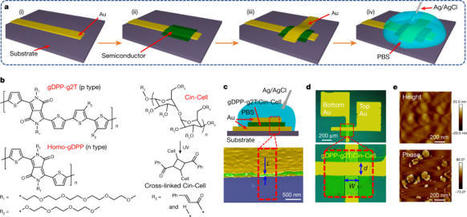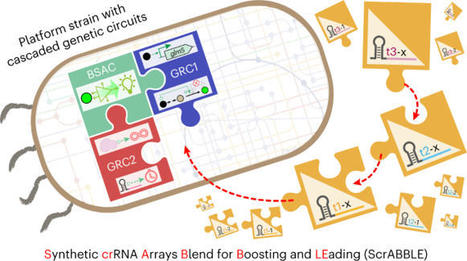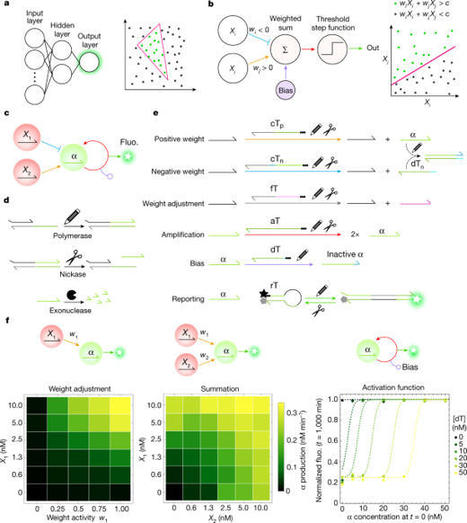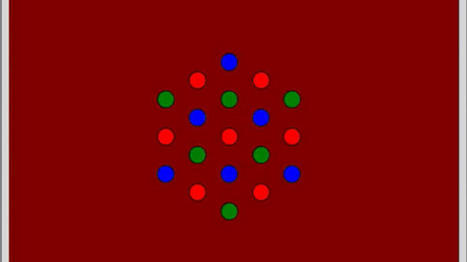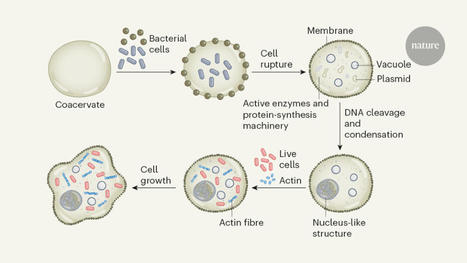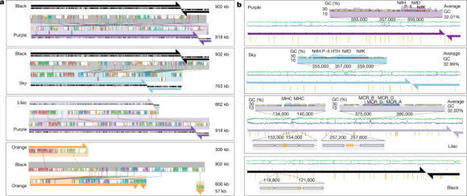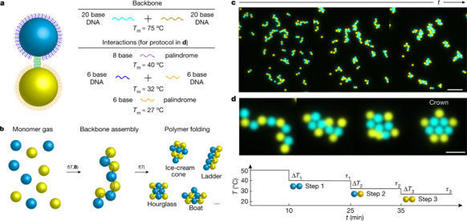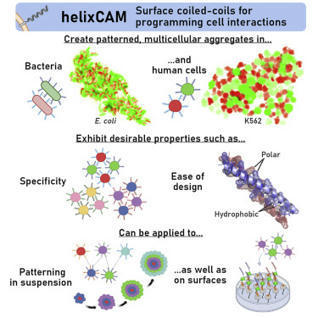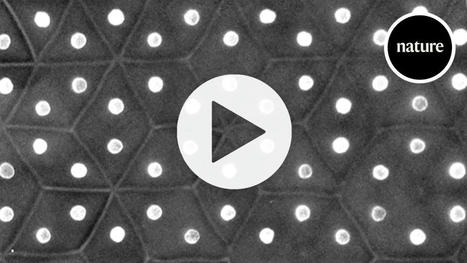 Your new post is loading...
 Your new post is loading...
Organic electrochemical transistors (OECTs) and OECT-based circuitry offer great potential in bioelectronics, wearable electronics and artificial neuromorphic electronics because of their exceptionally low driving voltages (<1 V), low power consumption (<1 µW), high transconductances (>10 mS) and biocompatibility1–5. However, the successful realization of critical complementary logic OECTs is currently limited by temporal and/or operational instability, slow redox processes and/or switching, incompatibility with high-density monolithic integration and inferior n-type OECT performance6–8. Here we demonstrate p- and n-type vertical OECTs with balanced and ultra-high performance by blending redox-active semiconducting polymers with a redox-inactive photocurable and/or photopatternable polymer to form an ion-permeable semiconducting channel, implemented in a simple, scalable vertical architecture that has a dense, impermeable top contact. Footprint current densities exceeding 1 kA cm−2 at less than ±0.7 V, transconductances of 0.2–0.4 S, short transient times of less than 1 ms and ultra-stable switching (>50,000 cycles) are achieved in, to our knowledge, the first vertically stacked complementary vertical OECT logic circuits. This architecture opens many possibilities for fundamental studies of organic semiconductor redox chemistry and physics in nanoscopically confined spaces, without macroscopic electrolyte contact, as well as wearable and implantable device applications. Vertical organic electrochemical transistors demonstrating unprecedented performances in both p- and n-type operation modes have been synthesized from new electro-active and ion-permeable semiconducting polymers by the interface engineering of electro-active blend layers.
The production efficiency of microbial cell factories is sometimes limited by the lack of effective methods to regulate multiple targets in a coordinated manner. Here taking the biosynthesis of glucosamine-6-phosphate (GlcN6P) in Bacillus subtilis as an example, a ‘design–build–test–learn’ framework was proposed to achieve efficient multiplexed optimization of metabolic pathways. A platform strain was built to carry biosensor signal-amplifying circuits and two genetic regulation circuits. Then, a synthetic CRISPR RNA array blend for boosting and leading (ScrABBLE) device was integrated into the platform strain, which generated 5,184 combinatorial assemblies targeting three genes. The best GlcN6P producer was screened and engineered for the synthesis of valuable pharmaceuticals N-acetylglucosamine and N-acetylmannosamine. The N-acetylglucosamine titer reached 183.9 g liter–1 in a 15-liter bioreactor. In addition, the potential generic application of the ScrABBLE device was also verified using three fluorescent proteins as a case study. The authors present a framework for multiplexed optimization of metabolic pathways based on CRISPR–dCas12a-mediated genetic circuits, which can be generally applied in the construction of microbial cell factories for sustainable bioproduction.
Cell adhesion molecules are ubiquitous in multicellular organisms, specifying precise cell-cell interactions in processes as diverse as tissue development, immune cell trafficking, and wiring of the nervous system.1–4 Here, we show that a wide array of synthetic cell adhesion molecules (synCAMs) can be generated by combining orthogonal extracellular interactions with intracellular domains from native adhesion molecules, such as cadherins and integrins. The resulting molecules yield customized cell-cell interactions with adhesion properties similar to native interactions. The synCAM intracellular domain identity dominates in specifying interface morphology and mechanics, while diverse homotypic or heterotypic extracellular interaction domains independently specify the connectivity between cells. This toolkit of orthogonal adhesion molecules enables rationally programmed assembly of novel multicellular architectures, as well as systematic remodeling of native tissues. The modularity of synCAMs provides fundamental insights into how distinct classes of cell-cell interfaces may have evolved. Overall, these tools offer powerful new capabilities for cell and tissue engineering and for systematically studying multicellular organization.
Artificial neural networks have revolutionized electronic computing. Similarly, molecular networks with neuromorphic architectures may enable molecular decision-making on a level comparable to gene regulatory networks1,2. Non-enzymatic networks could in principle support neuromorphic architectures, and seminal proofs-of-principle have been reported3,4. However, leakages (that is, the unwanted release of species), as well as issues with sensitivity, speed, preparation and the lack of strong nonlinear responses, make the composition of layers delicate, and molecular classifications equivalent to a multilayer neural network remain elusive (for example, the partitioning of a concentration space into regions that cannot be linearly separated). Here we introduce DNA-encoded enzymatic neurons with tuneable weights and biases, and which are assembled in multilayer architectures to classify nonlinearly separable regions. We first leverage the sharp decision margin of a neuron to compute various majority functions on 10 bits. We then compose neurons into a two-layer network and synthetize a parametric family of rectangular functions on a microRNA input. Finally, we connect neural and logical computations into a hybrid circuit that recursively partitions a concentration plane according to a decision tree in cell-sized droplets. This computational power and extreme miniaturization open avenues to query and manage molecular systems with complex contents, such as liquid biopsies or DNA databases. Mimicking traditional digital neural networks with DNA-encoded ‘enzymatic’ neurons overcomes issues with other chemical approaches, and could allow notable increases in miniaturization and molecular implementation of these AI models, with potential applications including DNA data storage or cancer diagnosis.
Utilizing chemo-mechanical oscillations to mimic protocell behavior in manufactured microcapsules The complexity of life on earth was derived from simplicity: from the first protocells to the growth of any organism, individual cells aggregate into basic clumps and then form more complex structures. The earliest cells lacked complicated biochemical machinery; to evolve into multicellular organisms, simple mechanisms were necessary to produce chemical signals that prompted the cells to both move and form colonies. ........
A synthetic system that reproduces several attributes of living cells.
Humankind relies on specialized metabolites for medicines, flavors, fragrances, and numerous other valuable biomaterials. However, the chemical space occupied by specialized metabolites, and, thus, their application potential, is limited because their biosynthesis is based on only a handful of building blocks. Engineering organisms to synthesize alternative building blocks will bypass this limitation and enable the sustainable production of molecules with non-canonical chemical structures, expanding the possible applications. Herein, we focus on isoprenoids and combine synthetic biology with protein engineering to construct yeast cells that synthesize 10 non-canonical isoprenoid building blocks with 16 carbon atoms. We identify suitable terpene synthases to convert these building blocks into C16 scaffolds and a cytochrome P450 to decorate the terpene scaffolds and produce different oxygenated compounds. Thus, we reconstruct the modular structure of terpene biosynthesis on 16-carbon backbones, synthesizing 28 different non-canonical terpenes, some of which have interesting odorant properties. Establishing methods to access the chemical space that lies beyond canonical terpenoid biosynthesis will increase the applications of isoprenoids. Here, the authors reconstruct the modular structure of terpene biosynthesis on 16-carbon backbones by engineered yeast and synthesize 28 different unique terpenes.
Design of de novo synthetic regulatory DNA is a promising avenue to control gene expression in biotechnology and medicine. Using mutagenesis typically requires screening sizable random DNA libraries, which limits the designs to span merely a short section of the promoter and restricts their control of gene expression. Here, we prototype a deep learning strategy based on generative adversarial networks (GAN) by learning directly from genomic and transcriptomic data. Our ExpressionGAN can traverse the entire regulatory sequence-expression landscape in a gene-specific manner, generating regulatory DNA with prespecified target mRNA levels spanning the whole gene regulatory structure including coding and adjacent non-coding regions. Despite high sequence divergence from natural DNA, in vivo measurements show that 57% of the highly-expressed synthetic sequences surpass the expression levels of highly-expressed natural controls. This demonstrates the applicability and relevance of deep generative design to expand our knowledge and control of gene expression regulation in any desired organism, condition or tissue. Design of de novo synthetic regulatory DNA is a promising avenue to control gene expression in biotechnology and medicine. Here the authors present EspressionGAN, a generative adversarial network that uses genomic and transcriptomic data to generate regulatory sequences.
Three-dimensional bioprinting: A cutting-edge tool for designing and fabricating engineered living materials
Highlights - •
-
3D bioprinting technology shows attractive potential for the manufacture of engineered living material (ELM). - •
-
Selection of living components and matrix biomaterials is reviewed. - •
-
Mechanisms of 3D-printed ELMs realizing functions are discussed. - •
-
3D bioprinting technology enables precise control over the distribution of different cells. - •
-
Widespread applications of 3D-printed ELMs are reviewed, providing new ideas for future research directions.
The catalytic asymmetric construction of Csp3–Csp3 bonds remains one of the foremost challenges in organic synthesis.1 Metal-catalyzed cross-electrophile couplings (XEC) have emerged as a powerful tool for C–C bond formation.2-5 However, coupling two distinct Csp3-electrophiles with high cross- and stereoselectivity continues as an unmet challenge. Here, we report a highly chemo- and enantioselective Csp3–Csp3 XEC between alkyl halides and nitroalkanes catalyzed by flavin-dependent ‘ene’-reductases. Photoexcitation of the enzyme-templated charge-transfer complex between an alkyl halide and flavin cofactor enables the chemoselective reduction of alkyl halide over the thermodynamically favored nitroalkane partner. The key C–C bond-forming step occurs via the reaction of an alkyl radical with an in situ generated nitronate to form a nitro radical anion that collapses to form nitrite and an alkyl radical. An enzyme-controlled hydrogen atom transfer affords high levels of enantioselectivity. This reactivity is unknown in small molecule catalysis and highlights the potential for enzymes to use new mechanisms to address long-standing synthetic challenges.
|
A recent study reports the development of a biomarker-responsive engineered bacterium that can diagnose, record and treat inflammatory bowel disease in mice.
A pilot program for synthetic biology education via a scalable distributed network model of distance-based laboratory learning can be accessible globally across disciplines and backgrounds.
Oxygen-containing functional groups are nearly ubiquitous in complex small molecules. The installation of multiple C–O bonds by the concurrent oxygenation of contiguous C–H bonds in a selective fashion would be highly desirable but has largely been the purview of biosynthesis. Multiple, concurrent C–H bond oxygenation reactions by synthetic means presents a challenge,1–6 particularly because of the risk of overoxidation. Here, we report the selective oxygenation of two or three contiguous C–H bonds by dehydrogenation and oxygenation, enabling the conversion of simple alkylarenes or trifluoroacetamides to their corresponding di- or tri-acetoxylates. The method achieves such transformations by the repeated operation of a potent oxidative catalyst, but under conditions that are selective enough to avoid destructive overoxidation. The reactions are achieved using electrophotocatalysis,7 a process that harnesses the energy of both light and electricity to promote chemical reactions. Notably, judicious choice of acid allows for the selective synthesis of either di- or trioxygenated products.
Anaerobic methane oxidation exerts a key control on greenhouse gas emissions1, yet factors that modulate the activity of microorganisms performing this function remain poorly understood. Here we discovered extraordinarily large, diverse DNA sequences that primarily encode hypothetical proteins through studying groundwater, sediments and wetland soil where methane production and oxidation occur. Four curated, complete genomes are linear, up to approximately 1 Mb in length and share genome organization, including replichore structure, long inverted terminal repeats and genome-wide unique perfect tandem direct repeats that are intergenic or generate amino acid repeats. We infer that these are highly divergent archaeal extrachromosomal elements with a distinct evolutionary origin. Gene sequence similarity, phylogeny and local divergence of sequence composition indicate that many of their genes were assimilated from methane-oxidizing Methanoperedens archaea. We refer to these elements as ‘Borgs’. We identified at least 19 different Borg types coexisting with Methanoperedens spp. in four distinct ecosystems. Borgs provide methane-oxidizing Methanoperedens archaea access to genes encoding proteins involved in redox reactions and energy conservation (for example, clusters of multihaem cytochromes and methyl coenzyme M reductase). These data suggest that Borgs might have previously unrecognized roles in the metabolism of this group of archaea, which are known to modulate greenhouse gas emissions, but further studies are now needed to establish their functional relevance. Borgs are remarkably large, divergent archaeal extrachromosomal elements with metabolic genes linked to the methane cycle.
In the realm of particle self-assembly, it is possible to reliably construct nearly arbitrary structures if all the pieces are distinct1–3, but systems with fewer flavours of building blocks have so far been limited to the assembly of exotic crystals4–6. Here we introduce a minimal model system of colloidal droplet chains7, with programmable DNA interactions that guide their downhill folding into specific geometries. Droplets are observed in real space and time, unravelling the rules of folding. Combining experiments, simulations and theory, we show that controlling the order in which interactions are switched on directs folding into unique structures, which we call colloidal foldamers8. The simplest alternating sequences (ABAB...) of up to 13 droplets yield 11 foldamers in two dimensions and one in three dimensions. Optimizing the droplet sequence and adding an extra flavour uniquely encodes more than half of the 619 possible two-dimensional geometries. Foldamers consisting of at least 13 droplets exhibit open structures with holes, offering porous design. Numerical simulations show that foldamers can further interact to make complex supracolloidal architectures, such as dimers, ribbons and mosaics. Our results are independent of the dynamics and therefore apply to polymeric materials with hierarchical interactions on all length scales, from organic molecules all the way to Rubik’s Snakes. This toolbox enables the encoding of large-scale design into sequences of short polymers, placing folding at the forefront of materials self-assembly. For a minimal model system of colloidal droplet chains, with programmable DNA interactions, it is shown that controlling the order in which interactions are switched on directs folding into unique structures.
Dynamics of mobile catalytic capsules in solution can mimic the behavior of protocells Chemical reaction networks enable the exchange of signals between separate capsules Chemical heterogeneities in fluids enable aggregation of capsules into mobile colonies Reconfigurable clusters produce lifelike collective chemo-mechanical oscillations https://www.sciencedirect.com/science/article/abs/pii/S2590238522003988?via%3Dihub
Advancing the spontaneous bottom-up construction of artificial cells with high organizational complexity and diverse functionality remains an unresolved issue at the interface between living and non-living matter1–4. Here, to address this challenge, we developed a living material assembly process based on the capture and on-site processing of spatially segregated bacterial colonies within individual coacervate microdroplets for the endogenous construction of membrane-bounded, molecularly crowded, and compositionally, structurally and morphologically complex synthetic cells. The bacteriogenic protocells inherit diverse biological components, exhibit multifunctional cytomimetic properties and can be endogenously remodelled to include a spatially partitioned DNA–histone nucleus-like condensate, membranized water vacuoles and a three-dimensional network of F-actin proto-cytoskeletal filaments. The ensemble is biochemically energized by ATP production derived from implanted live Escherichia coli cells to produce a cellular bionic system with amoeba-like external morphology and integrated life-like properties. Our results demonstrate a bacteriogenic strategy for the bottom-up construction of functional protoliving microdevices and provide opportunities for the fabrication of new synthetic cell modules and augmented living/synthetic cell constructs with potential applications in engineered synthetic biology and biotechnology. A bacteriogenic strategy for constructing membrane-bounded, molecularly crowded, and compositionally, structurally and morphologically complex synthetic cells provides opportunities for the fabrication of new synthetic cell modules and augmented living/synthetic cell constructs.
Microrobots and nanorobots are booming technology for various biomedical applications, ranging from targeted drug delivery to minimally invasive surgery . These tiny robots can cruise through the whole human body, performing medical tasks down to cellular level and offering localized diagnosis and treatment with greater precision and efficiency http://d-scholarship.pitt.edu/42944/1/Wei_Ting-Yen_ETDV3_2022.pdf
Engineered orthogonally interacting coiled coils presented on the surface of cells
enable specific cell-cell or cell-surface interactions for the controlled formation
of complex multicellular structures and patterns from bacterial and human cells.
Post-gastrulation stages of development with organ progenitors and complex extra-embryonic
compartments are achieved ex utero entirely from assembled naive mouse embryonic stem
cells.
How researchers created complex tiling patterns with bioengineered bacteria
|




 Your new post is loading...
Your new post is loading...
